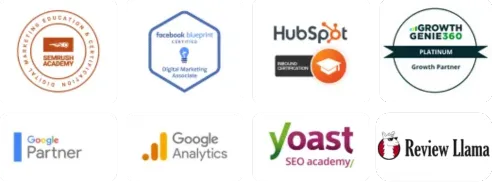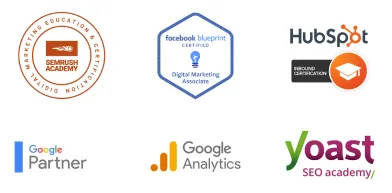TO LEARN IS TO GROW
Learning Center
We do our research and publish our results. Should probably call this the Growing Center.


Increase Your Website Traffic: How Do I Bring in More Visitors To My Business Website?
Generating website traffic is probably the most important skill of any digital marketing professional or site owner. More traffic means more website visitors, which means more leads that can be nurtured and converted into much-welcome sales.
A question we commonly get among business owners goes something like this: “After I get my website up and running, how do I now get customers to visit my website?”
With a digital marketing approach, there are three ways you can accomplish this: through pay-per-click ads (or online advertising), online P.R., and search engine optimization. We also believe that brand-building certainly helps in bringing more visitors– more well-established, more trustworthy brands are likely to draw in more leads than its competitors.
Can My Small Website Compete With Bigger Business Websites?
Thanks to Google’s diversity update in June 2019, smaller sites now have more opportunities to rank (and therefore bring in more website traffic) as new adjustments are now in effect limiting the number of times a single domain can appear in a single SERP.
In other words: yes, even with a small website, you can rank relatively much better now.
With this recent Google update, you now have a chance to rank among traditionally top-ranking sites like Amazon (because they sell so much stuff) or some other big brand within your space.
What Steps Can I Now Take To Rank My Site (Really Quickly)?
Here are a number of action items we’ve put together to help your business website achieve the rankings you need and the traffic that comes along with it.
(Have a look at the Table of Contents we’ve provided.)
This list of action items almost represents a complete marketing, branding, and P.R. strategy you can easily implement on your business website.
It does cover a lot of ground, and certainly has a lot of work involved. We have simplified it as much as we can to at least include the essentials as far as content marketing, SEO, link-building, and marketing strategy are all concerned.
That said, let’s go dive right in:

Setting Yourself For Success
First things first. You need to be familiar with who you’re targeting, and you need to have your website set up nicely. So before you do anything, cover these first few action items.
1. Optimize For Your Target Audience
Having tons of traffic is good. But remember to optimize for your target audience. Remember, these are the website visitors who will actually end up being your readers, your leads, and hopefully, your customers.
Knowing exactly who it is you’re catering to will greatly aid your inbound and content marketing strategies moving forward.
What this means is: you have an almost laser-clear approach to creating thoughtful content that actually helps your readers become more aware of their problems or pain points, then educates them further so they know what solutions and action items are available.
For a quick review of getting to know your target audience even better, check out our recent piece, “Buyer Personas: Why They Are Important and Why You Should Have Them.”
2. Go For an Exact-Match Domain Name (if you can)
One way to give you an added boost in search ranking is to use an exact-match domain name. An exact-match domain name is what you get when your own main keywords are actually part of the domain.
Does having an exact-match domain name still work in 2020? Yes, it can, but you’ll have to be smart with your SEO.
The main idea is to think beyond just putting in your key terms or phrases in there and consider a version of an exact-match domain name that can also be a built up as a brand.
So if you’re selling wedding cakes, for example, don’t go for something too generic, like weddingcakes.com, for example.
Instead, you’ll want some variation that might more closely describe what you’re all about, such as imakeweddingcakes.com, weddingcakesandmore.com, and so on.
This can work best with long-tail keywords or more localized keywords, rather than for head terms. Using the example above, you might be able to score better rankings with howtomakeweddingcakes.com or sacramentoweddingcakes.com.

(Namecheap is just one of several domain registrars where you can get a cool name. Other popular domain registrars include Bluehost, HostGator, GoDaddy, Domain.com, DreamHost, and yes, even Shopify.)
3. Make Your Site Mobile-Friendly
As of July 2019, Google had been utilizing a mobile-first indexing system for new sites.
What this means is: the search engine giant has recognized the importance of how more users now look for information via their mobile devices. In fact, about 60% of all search queries are now being done on a mobile device.
So make sure your business website is responsive (which means “mobile-friendly”), and that it loads quickly enough on mobile devices as well.
Also: Site responsiveness also goes hand in hand with both page speed and site performance– so make sure you optimize for those too.
Do Your Homework. Do Some Research.
The next step to building up your website traffic is to actually have some plan or strategy to do so. Start things off with some keyword research and identify the right topic opportunities you can take advantage of.
You’ll also want to map out your content strategy, and when you can, snoop into your competitor’s content marketing strategies as well.
4. Focus on Long-Tail Keywords
Especially if you’re just starting out as a business website or if you’re now just making a serious attempt to gain some rankings, digging into long-tail keywords for your niche is a great way to find high-quality traffic.
Long-tail keywords get less search traffic, but they do have the advantage of having higher conversion rates. Just because they’re more specific in nature, ranking well with long-term keywords means you can bring in more leads, more conversions, and more sales.
It’s a reason why longer, more comprehensive articles on a particular topic would do quite well in terms of rankings. These blog posts actually have lots of long-tail keywords built into their copy, making them appealing to visitors looking for that exact sort of information.
What makes a keyword a long-tail keyword? Long-tail keywords (they’re more like key phrases) are a lot more specific and are usually longer. In many cases, these can even be questions or more commonly-searched phrases around a topic.
Some excellent tools for finding long-tail keywords might include:
5. Map Out Your Buyer’s Journey
Connected to items #3 and #4 is the Buyer’s Journey: a three-stage process a buyer goes through to become aware of, consider and evaluate, and decide to purchase a new product or service.

Each stage of the Buyer’s Journey represents a different search intent and therefore, different goals in mind when creating content for your target audience.)
Each of these three stages has recommended pieces of content that will best resonate with your readers, depending on which stage of the buyer’s journey they’re at currently.
Familiarizing yourself with the buyer’s journey your customers go through aids greatly in your overall business website strategy, allowing you to focus on creating content that’s even more relevant and helpful.
6. Have a Look at the Competition
Now before you go creating your content, have a quick look at what your competitors are already doing.
The tools we’ve mentioned in item #4– enter your competitor’s URLs and see what you can find out. Ubersuggest, for example, can give you a glimpse of their traffic, their top pages, and what keywords they might actually be using.
This way, you now know which are their most high-performing pages of content and what topics they’re already covering.
Other tools to help you research your competitors would include Buzzsumo, SimilarWeb, as well as the tools we mentioned above in Item #4, and a bunch of others.
Let’s Go Create Some Content
Now that you’ve done your homework (i.e. your keyword research, your buyer’s personas and buyer’s journeys, and your research into the competition), you can now create a sound content marketing strategy.
7. Create Some Top-Notch Content
First of all, let’s put this out there right now: for your business website, you don’t need a ton of content. But you do need some, and whatever it is that you have must be top-notch and hard-hitting.
Definitely a quality-over-quantity game plan here. Now that you’ve done your research, you’ll want to cover the keywords and topics you’ve laid out for yourself.
Your blog posts shouldn’t be 300-to-500 words, but rather more long-form (like with upwards of 1200 to 1500 words per piece). You don’t have to pump out a piece each day; you’re better off creating a high-quality piece of content each week or every two weeks if that’s a schedule you’re comfortable with.
If you have the budget for it, consider hiring some freelance writers or maybe even a local digital marketing agency to bolster your content creation efforts. A sustainable output of fresh content is good, but having a bank of great content allows you to plant the seeds even faster so you can reap the benefits of improved organic traffic much sooner.
For even more tips on making your content stand out even further, check out our guide, “12 Useful Tips on How To Write Better Blog Articles (For Your Business)”.
Other quick tips on creating killer content?
Take this opportunity to answer your customers’ frequently asked questions
Create comprehensive guides covering several connected subtopics of your chosen topics
Have accompanying media: graphics, video, graphs, charts– whatever you need to make your topic easier to understand and follow.
Cite your sources: let folks know where you’re getting your information and link-building those facts you’re throwing out there.
Invest a bit of time on design– make your blog posts a joy to read. Break up big blocks of text, use a generous amount of whitespace, and don’t hesitate to use breakout areas and subheaders.
Link to your other great pieces of content, especially if they’re relevant to your piece.
Don’t worry about stuffing your keywords in: especially as you’re writing long-form content, a lot of these will naturally flow from you as you cover your topic.
8. Get Into Video When You Can
Think about it this way: any topic worth writing thousands of words about is just a perfect subject matter for video.
It goes without saying that your blog posts and articles can gain a lot just by having related relevant video embedded in them. What you’ll want to do is start creating your own branded video content and nurture a YouTube channel to showcase all that great stuff that you have.
Remember: people gain and retain a lot of useful information when they watch videos compared to reading an article. And a YouTube channel is not only an excellent branding opportunity, it’s also the second biggest search engine after Google, helping you generate traffic to your business website.
9. Create Valuable Specialty Content (in Your Niche)
To really own your niche, start showcasing your expertise by creating something absolutely mind-blowing in terms of content.
Be in the habit of developing ebooks, reports, definitive guides on your chosen topic. Start with an ebook, for example, and get comfortable with the process. Perhaps an industry report, or a comprehensive survey or research about the current state of your
Your niche-specific specialty content is great for your content marketing efforts. Not only are you being genuinely helpful to your target audience, but you’re also helping your site rank better on search engines.
So if you’re in the business of wedding cakes, for example, what’s the one insanely helpful resource you can come up with for your target audience?
A step-by-step guide on how to make the most awesome wedding cake for 2020, complete with which equipment to use, and what new techniques to employ?
A guide on how to do weddings in your neighborhood, complete with recommended wedding venues and vendors?
A blueprint on how to set up a thriving wedding cake shop business, complete with marketing plans, sales strategies, and more?
10. Mind Your On-Page Optimization
You’ve got the content part nailed down; now it’s all about the SEO. Again, you don’t have to cover it all; you just have to cover the most important adjustments to help make your content a lot more search-engine friendly.
For a quick review on SEO, check out our piece, “What Do I Need To Know About SEO? (9 Things You Should Know as a Business Owner).”
Search engine optimization today is less about stuffing in keywords, and more about giving your readers (your customers) the best possible experience you can give them.
Remember: you gotta nail down your on-page SEO first before moving on to do your off-page optimization, technical SEO, and local SEO.
We already touched on some of these in item #7. Here are a few more:
Make sure you have your main keyword included in the following: your headline, your URL slug, your meta description, your first 100 words, your image alt tags, and a bit throughout your content.
Optimize your headline. Remember– you want a compelling headline so people can choose to read your piece when they see it in a search engine results page.
All that media you created? The graphics, the video, the images, and all that– label them accordingly and don’t forget to optimize those alt tags as well.
Use subheaders (H2s, H3s, and H4s) to thoughtfully organize your content, breaking down big blocks of text, and making your piece easier to skim through.
11. Come Up With Even More Comprehensive, More Helpful Showcase Pieces
The content landscape today is highly competitive. 10-15 years ago, it was OK to just churn out 200-300-word pieces on the same topic and call it a day.
These days, as we’ve discussed, it’s all about quality. Yes, you’re going to make your regular content. But every now and then, you will want a showcase piece.
What’s a showcase piece?
These pages have enough information to probably fill up a good-sized ebook. (Which you should probably make as well.)
These pages link to your other blog articles, resources, and proprietary content on the topic. (And these, in turn, link back to this page.)
They’re more thoughtfully designed and optimized for an even more pleasant reading experience.
In some cases, these might even be designed with the goal of being cited as a resource by others in your space/industry.
Some people may call these Cornerstone pages, or 10X pages, or Skyscraper content, or Pillar Pages. These various types of showcase pages may serve different purposes somewhat, but in the end, they’re all pages with massive amounts of amazing (and useful) content.
Bottom line: whatever space you’re in, your showcase page has to be mind-blowing. Especially if you have competitors that are also creating content and getting traffic.
Note: Your showcase piece is the culmination of If you know who you’re writing for (i.e. your target audience/buyer personas) and what exactly you need to write about (i.e. your researched keywords), then you should have no problem creating your big showcase content pieces.
Continue Brand-Building
One thing that you must remember as a business is that you’re also a brand. You are a recognizable part of both the real-world and the online community. You have customers and leads who’ll eventually be customers.
What this means is: just as important as creating content is recognizing that you need to keep building your brand. Brand-building activities all contribute to establishing yourself as an expert in your space, an authority, and someone your customers can trust.
12. Build Up a Following
As much as your customers interact with you in the real world, they can do so just as well online. Social media allows you to build your brand through genuine, unfiltered interactions with your customers and your online audience.
Especially as a small local company, your strength is in your personal engagements with your customers. Responding to comments you get on your website, on your social channels, as well as in real life are all opportunities to win the hearts and minds of your audience just by being true to yourself.
One of the best ways to build a strong following online? Make use of Facebook pages and groups; try to build a community of like-minded folk who have the same issues and pain points, that you can also help with your own brand of content (and yes, your products and services too later on.)
The key is to be personal and real. Remember: folks are a lot savvier these days and are more discerning: so they can tell when you’re faking it and when you’re being genuine.
Back to our example: if you’re running a wedding cake business, offer your wedding expertise (on not just cakes!) to soon-to-wed couples looking for advice on how to prepare for a wedding in your area.
Or, if you’re catering to other bakers, offer some useful tips and techniques on cake decorating via video and social media.
13. Keep Collecting Emails
Email marketing is one of the most underutilized tools at your disposal. Here’s what you can do to use emails to bring more folks back to your site.
First off: get into the habit of collecting emails. Services such as Hello Bar, HubSpot, or Sumo Smart Bar can help you with this task. These allow you to collect emails through strategically timed popups and sliders and works best if you also have free resources to give out (such as those we covered in item #9).
Next: soon enough, you not only have an email list, you also have a push notification list. So when you have a new blog post published, you can quickly update all the people in your lists to come check out your new content.
Even with just two solid pieces of blog content each week, you can rack up a fairly impressive email list in a few months.

14. Leverage on Local SEO
Especially if you’re an active neighborhood business, you must capitalize on Local SEO. Think of it as an add-on to regular search engine optimization and this one was designed by Google to support local businesses like yourself.
Some simple yet effective action items to boost your local SEO rankings are the following:
Claim your Google My Business listing and optimize it. You can read more about that here: “Why Is It Important to Optimize My Google My Business Listing?”
Add awesome photos of your facilities, your team behind-the-scenes, your clients, your products and services, your promotions, and so on– anything you have on hand to show folks you’re a real member of the community.
Optimize your business website for local by creating a dedicated “Contact Us” page. This should have your name, address, and phone number/s, as well as map listings of where you’re located. If you have multiple locations or offices, have a separate location page for each, but have your business’s main address and phone number located in the footer of your site.
Speaking of your business phone number, make sure it isn’t a 100 number. Rather, ensure it’s a local number so folks can click on that number and dial straight away from their mobile phones.
Add testimonials as proof that you’re a real business– folks appreciate that. With that, make it a habit of collecting client testimonials. Even better, try to capture those on video somehow. (See #8).
Add local business schema markup.
Claim other relevant business profiles such as Yelp and TripAdvisor. Your Facebook business page also falls in this category.
Next Level Stuff: More Ways To Bring in More Traffic
The first 14 items we laid out for you are already good enough to bring in quite a bit more traffic for you. As a matter of fact, we recommend that you keep at it with those fourteen steps.
But if you have extra time, manpower, and resources, the following action items can really bring in the traffic for you.
A lot of these tips are all about promoting your content. Now, normally we’d say focus on creating all that awesome content. But once you already have a couple of showcase pieces ready, perhaps it’s time to kick things up a notch and put in some time towards promoting your branded content.
15. Use Push Notifications
Another underutilized way to keep folks coming back to your site: push notifications.
It’s just like email marketing, but these are little updates and reminders via mobile phone or messaging apps. You can also use services such as Subscribers.com or VWO Engage to get folks to subscribe to you when they come to visit you via their browser.
These services allow for hassle-free ways to collect info from visitors stopping by your site; the information is already with Facebook (for example) and so they don’t have to put in an email or any other further personal info.
So the next time you publish new content or run a promotion, you can message everyone in your push notification list so they can come back to your site.
16. Invest in Some Paid Advertising
Especially if you already have some choice branded content and a system in place to collect and nurture leads (like a suitable landing page, and maybe a sales team to nudge your leads towards conversion), then you should seriously consider putting in some paid ads.
Pay-per-click advertising is a great way to get a quick hit of traffic in the short-term. It works well combined with your SEO (for your sustainable, long-term organic traffic) and your online P.R. and outreach efforts (for the gap between PPC and SEO).
Google is always great for your online ad efforts, but don’t forget to look into other great options for reaching your market as well like the Microsoft Ad network (Bing/Yahoo!), platforms like Facebook and Instagram, and even places like Reddit, Amazon, and YouTube.
Remember: running paid ads can be quite the investment, so make sure you properly optimize your campaigns and conversions to make sure you’re getting a return on your investment. When you do see some sales coming in via your ads, it’s OK to put back in a bit of your budget so you can keep your ad efforts going.
Also: do keep your campaigns fresh and switch things up once in a while.
17. Find Ways To Co-Create Content With Others
Of course, you can do the round of trying to get you (and your awesome content and ideas) featured in other blogs, in other podcasts, and maybe even in some local media outlets.
This is certainly all good and worth pursuing if you can. Another approach you might want to consider is partnering with like-minded folks within your space to come up with something even better.
So we’re talking about perhaps a joint podcast series, a blog roundtable of experts, or a roundup webinar. (Notice how podcast hosts get a guest or two and then show up as a guest on their podcasts as well?)
Even if you don’t have traffic yet, there are other folks within your space that see the value in being interviewed or sharing their expertise on your video series or on your blog. Then you’ll find that they’ll tweet or share about their interview as well on social media, reaching out to their fans and followers who can now check you out in turn.
So back to your wedding cake business: even if no one has a podcast yet, maybe you can join forces with other wedding vendors in your neighborhood and start one. By partnering in this manner, you’ll see that they’ll promote your new joint project (and you’ll of course promote it as well).
18. Do Giveaways, Contests, and Promotions
We’re not just talking about any giveaway. Sure, folks love giveaways. They spread the word, you get some traffic, and you get a few new followers and fans in the process.
In the same way that you’re very thoughtful and creative about your branded content, so too should you be when designing your promotions and giveaways. Which means you’ll want something that your target audience can really appreciate
Again, going back to our example: if you’re in the wedding cake business, you can come up with a creative wedding reception package that bundles together your wedding cake along with other vendors for wedding souvenirs, catering, or a dessert bar or a grazing bar.
Every so often, you might want to scour your Twitter or Instagram and decide to give out a free Engagement cake, Groom’s cake, or Anniversary cake to a deserving couple.
19. Look Into Even More Backlink Opportunities
High-quality backlinks and high-quality content are two of the most important Google ranking factors that we know of. Earning those backlinks is certainly challenging, but it’s also very rewarding, as these greatly boost your ranking in search results.
Start with your low-hanging fruit of backlinks: your company-owned web assets, your social media profiles, local business listings, links from press releases, and other directories that cover your industry or space.
Regular outreach: every time you publish a new piece of content, go ahead and reach out with a quick email, and just let them know you’ve linked out to them in your piece. As you send them a link to your blog post, you can just casually ask them to share it. Best case scenario: they share your article on social media and they link back to you as well.
Use a little BuzzSumo: Type in your competitors’ URL into Buzzsumo and check out the “View Shares” option on their most high-performing articles. This will show you the different people in the space who share pieces of content like these.
If you have your awesome new branded piece ready (from #9), go ahead and reach out to them and ask them to share your piece as well.
Bonus Tip: Build Up a Roster of Promoters and Brand Champions
This one works just like #13 and #15, or maybe even as part of your efforts under #12.
As you ask folks to keep coming back to your site and share or link back to your content, you might notice a pattern in which some people are more willing or are more likely to do so.
Yes, you can just go ahead and keep doing that when you come up with a new guide or new branded content. But you can also come up with a very special way of giving thanks or showing your appreciation to encourage that behavior of sharing and/or linking back to you.
It’s sort of like having your own set of micro-influencers: links and shares are all well and good but don’t forget that they also have a great deal of clout, which means big potential for good word-of-mouth as well.
A Final Word
So there you have it: a fairly exhaustive list of action items to help you bring in more high-quality traffic to your business website.
Do you think you need to rework your strategy from the beginning? Or do you think your brand can handle a bit more of link-building right now? We’d love to hear from you and what you think about this list; feel free to reach out to us and let us know.
These are all fairly easy to accomplish, but some are, understandably, a lot of work. If you think you need some further help in getting some things done for your business website, don’t hesitate to get in touch with us here at LOJO.
Built for Growth. Backed by 25 Years of Trust.
For over two decades, LOJO has been a trusted partner to hundreds of businesses just like yours. Whether working directly with owners, managers, teams, or boards of directors, our goal remains the same: to be a reliable and results-driven asset to your business.
Over the years, we’ve carefully built a team of experts—each selected for their unique skills, strengths, and personalities. Our clients choose LOJO because they know we genuinely care about their success.
And after 25 years of helping businesses grow, we’re more committed than ever.


Built for Growth. Backed by 25 Years of Trust.
For over two decades, LOJO has been a trusted partner to hundreds of businesses just like yours. Whether working directly with owners, managers, teams, or boards of directors, our goal remains the same: to be a reliable and results-driven asset to your business.
Over the years, we’ve carefully built a team of experts—each selected for their unique skills, strengths, and personalities. Our clients choose LOJO because they know we genuinely care about their success.
And after 25 years of helping businesses grow, we’re more committed than ever.




Matthew Rogers, President
iProspect Check
After spending several months reviewing multiple proposals from several different companies we engaged LOJO to develop a new website that represents our company effectively. We worked initially with Stephen Platte who helped create the scope of the project. Stephen was knowledgeable and always followed up with me on time and as promised.
He "closed the deal" for LOJO with his professionalism, service orientation and easy going approach. Once we signed the contract we were introduced to Jay Kelly who would be the creative lead for LOJO. This was the most challenging part of the project for my company, as there was no shortage of ideas from our side. Jay managed the project flawlessly, and once we had all agreed to the design, Jay introduced us to Eric.
Eric Lay is one of the founders of LOJO. Eric took the design we had developed and brought it to life. We delivered content as quickly as he requested it. Eric kept the project on task and we responded by exceeding every deadline for content. In turn, once provided, literally not a day went by that Eric didn't add the content and take the next step. In just a few weeks we launched our new website. Eric is a pleasure to work with.
His positive attitude and consultative approach really enhanced the experience and made a big difference for us in the outcome of our project. We would welcome you to visit our website to take a look at the quality work of LOJO. We are very pleased with LOJO and look forward to working with them in the future as we pursue an aggressive SEO strategy."
After spending several months reviewing multiple proposals from several different companies we engaged LOJO to develop a new website that represents our company effectively. We worked initially with Stephen Platte who helped create the scope of the project. Stephen was knowledgeable and always followed up with me on time and as promised.
He "closed the deal" for LOJO with his professionalism, service orientation and easy going approach. Once we signed the contract we were introduced to Jay Kelly who would be the creative lead for LOJO. This was the most challenging part of the project for my company, as there was no shortage of ideas from our side. Jay managed the project flawlessly, and once we had all agreed to the design, Jay introduced us to Eric.
Eric Lay is one of the founders of LOJO. Eric took the design we had developed and brought it to life. We delivered content as quickly as he requested it. Eric kept the project on task and we responded by exceeding every deadline for content. In turn, once provided, literally not a day went by that Eric didn't add the content and take the next step. In just a few weeks we launched our new website. Eric is a pleasure to work with.
His positive attitude and consultative approach really enhanced the experience and made a big difference for us in the outcome of our project. We would welcome you to visit our website to take a look at the quality work of LOJO. We are very pleased with LOJO and look forward to working with them in the future as we pursue an aggressive SEO strategy."

Matthew Rogers, President
iProspect Check
The team at LOJO were wonderful to work with. They are well organized and very patient as we worked through our marketing strategy and developed a well thought out and clear action plan at a reasonable price. We will definitely be back for our future campaign needs."

Jon Crosby, Founder
Dazil

